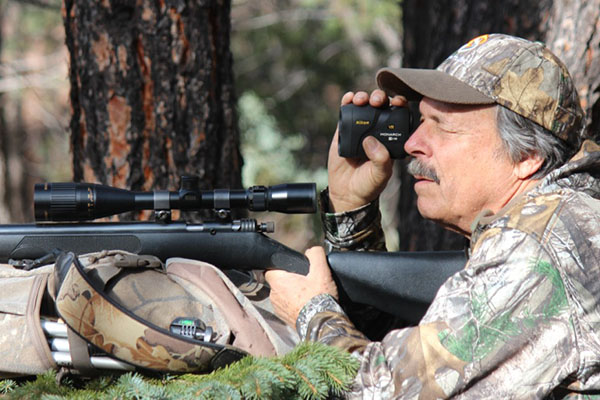
Last Updated on
By Tony Martins
When GRITR Spots blog editor David Link called to say that Nikon would be sending their new Monarch 7i VR Laser Rangefinder to me for review, I must admit that I was a little excited and anxious to give it a try – a rare occurrence and admission for someone who has written about outdoors adventures and gear for more than 20 years. Nikon is promoting this unit as the “World’s First” laser rangefinder to employ optical “Vibration Reduction” technology, and the head of their advertising and marketing outfit described it as a “game changer.” Wow! With that preface I immediately searched the internet, and quickly learned that every post and “review” listed was nothing more than a recital of product features and marketing points for the new 7i VR – but not this one… After 5 weeks of toting this new rangefinder around everyday, field testing it extensively, this review will be decidedly different.

It should be noted that I have considerable history with Nikon rangefinders. For the past 12 years I have used a Nikon LASER800 for most hunting and target shooting applications, and this unit was my baseline for comparing performance of the new 7i VR in this review. Last fall I used an Archer’s Choice model while bowhunting mule deer in Arizona and whitetails in Iowa, and two years ago I reviewed the Nikon Monarch Gold LASER1200 for GRITR, so many of the 7i VR’s features were already familiar from other Nikon models.
In my review of the Nikon LASER1200, it was noted that rangefinders can be categorized by two main parameters; cost and functionality (or intended use). Grouping by cost we have economy (under $200.00) and premium (over $600.00) models, and everything in between. I call this last one the “basic” sub-category, and with an MSRP of $399.95, the new 7i VR is well placed here. Grouping by functionality is much more interesting. The balance of this review will help readers understand how well the new 7i VR functions for bow hunting, rifle hunting, dual purpose hunting and target shooting applications.
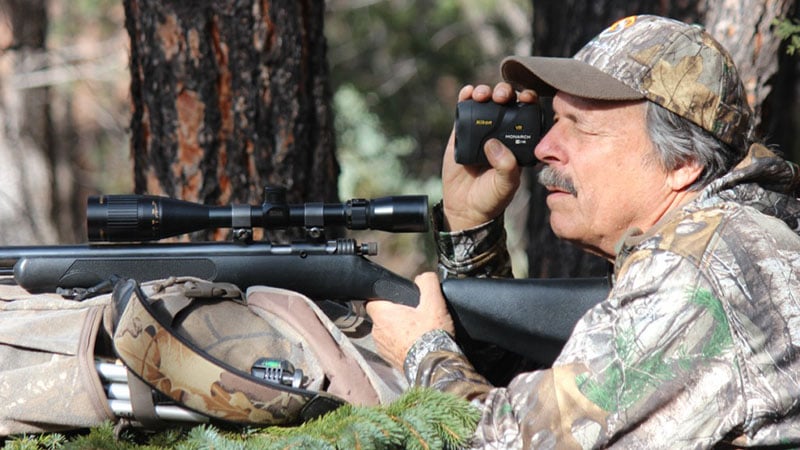
The big news with the 7i VR is the VR – which stands for Vibration Reduction. For many years, Nikon has been a leader in the camera and lens market with image stabilization technology, which essentially reduces movement from the photographer’s hands to produce sharper images. With the 7i VR, Nikon is the first to apply similar optical vibration reduction technology to a rangefinder, with the goal of producing quicker, more precise targeting and sharper, steadier imaging. By reducing the effect of external vibrations, the VR technology compensates for the physical inability of human hands and body to remain completely still. Thus, as distant objects are ranged the target mark (cross hair) in the 6-power viewer remains stable, even when the rangefinder body is moving. This makes it easier to hit the target and get a reading when the measurement button atop the unit is pressed.
The laser is also stabilized when activated, to facilitate more precise alignment as well as greater accuracy. Any hunter who has experienced the frustration of having to press the button on a compact rangefinder repeatedly to get a reading on an animal, and then wonder if the reading is accurate, will appreciate the VR capability.
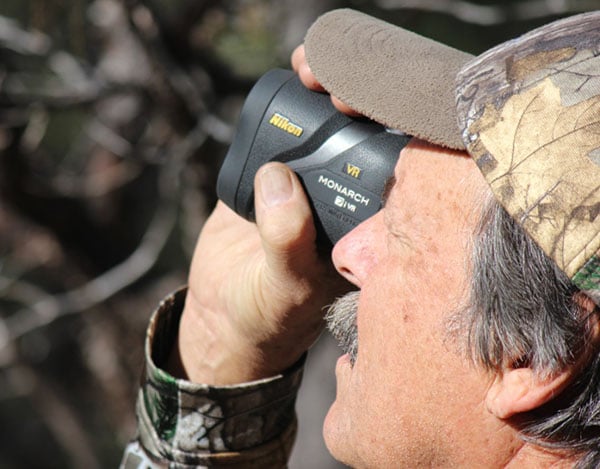
So, how does it work in the field? First time out with the new 7i VR I was so impressed that I was ready to buy one! A small herd of pronghorn was located on a grassy plain under partly cloudy skies, and individual animals were ranged from 187 to 297 yards. Each of the 30 times the measurement button was depressed a reading was obtained… remarkable! I also ranged a few bushy juniper trees near some of the animals to verify distances, and all readings were consistent with expectations. Furthermore, readings come quickly in about half a second, regardless of the distance.
The next day a band of bighorn sheep crossed the road in front of me and proceeded up the mountain. From a turnout in the pass at roadside I ranged a dozen or more of the animals as they moved up the mountain, testing both the continuous scan capability and the ID (Incline/Decline) technology. Again, virtually every ranging attempt produced a reading, from 55 to 288 yards. Holding the button down produces a continuous scan for up to 8 seconds, and this feature was impressive. One ewe moved nearly 20 yards up the mountain during the scan, which updated the distance reading at intervals of less than a second. The ID angle compensation feature appeared to function as advertised. The “horizontal” readings, calculated to compensate for uphill/downhill angles, were consistent with what I expected for each animal ranged, from 50-250 feet higher than my position. Note: A few days later I tested the angle compensation feature by comparing readings from the unit to my calculations using Pythagoras’ theorem (you know… a2 + b2 = c2 for any right-angled triangle). Out to 60 yards from an elevation of 45 feet, the readings were precise.
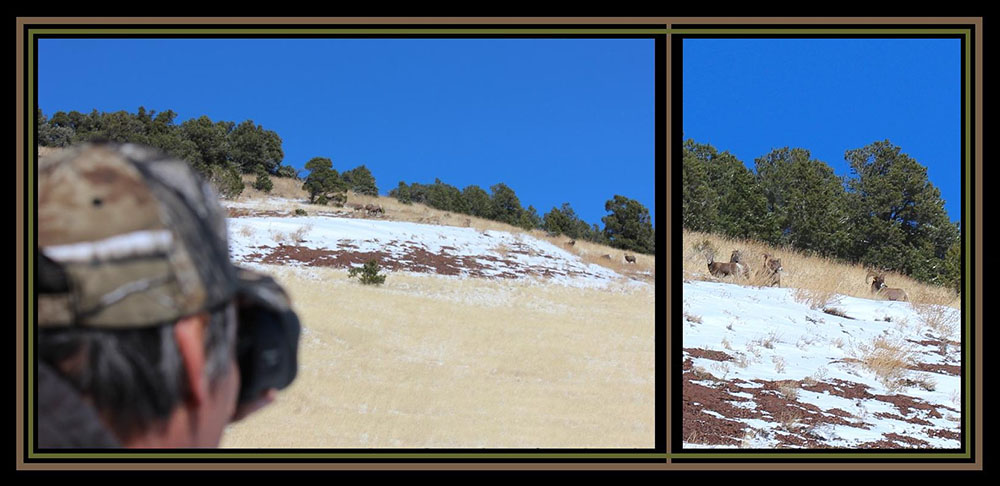
At this point in my testing, only light colored (white and light brown) animals had been ranged at measured distances out to 300 yards, with excellent results. Unfortunately the next round of testing – on flat, open cattle range during a pond-jumping duck hunt with my good friend and gunsmith Shane Clark – produced mixed results. We quickly learned that the 7i VR has difficulty ranging dark colored cows beyond 400 yards, and the unit would not range black cows beyond 240 yards at all. Furthermore, readings obtained inside 240 yards required multiple depressions of the measurement button. It should be noted however, that virtually all laser rangefinders have difficulty ranging black targets (some more so than others), as the laser is reflected inefficiently back to the receiver, or not reflected at all. The 7i VR is comparatively (and disappointingly) weak in this area, as my 12 year old LASER800 gave readings on the same black cows out to 380 yards (although multiple attempts were required to get each reading), and Shane’s Vortex Ranger 1000 gave first attempt readings out to 450 yards. Later I found the 7i VR had similar difficulty ranging elk standing in shadows at distances of more than 400 yards, and it failed to range a large bull coated with dark colored mud at approximately 440 yards on multiple attempts (although it did range the foliage of a nearby tree on the second try). For a rangefinder that is advertised as a 1000 yard unit, this would likely be considered poor performance by most hunters.
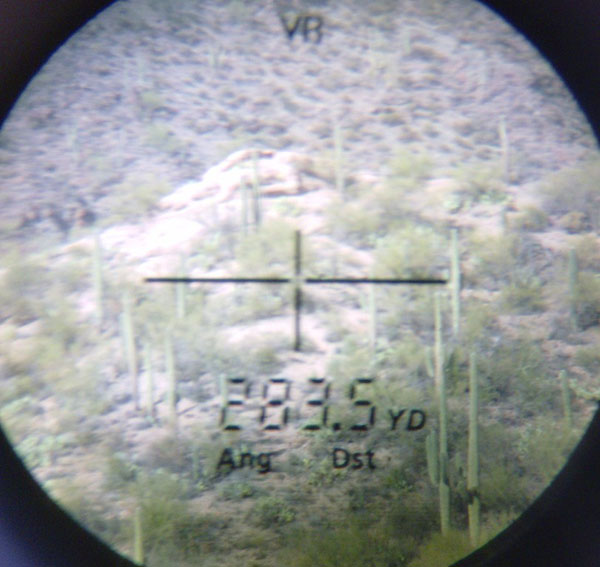
When considering a rangefinder purchase, it’s important to understand that the maximum ranging distance cited by the manufacturer is for ideal lighting and weather conditions on large, flat-sided, highly reflective targets – like a metal billboard or concrete building – and not for a target that will absorb or diffuse the laser pulse – like the furry body of an animal or the leaves of a tree. Thus, you can expect a model rated for 1000 yards to accurately range a stationary animal at least as far as 500 yards away. Furthermore, the better the quality of the optics, power of the laser and sensitivity of the receiver, the greater the effectiveness beyond this mid-point benchmark.
7i VR optics are bright and excellent quality. So, suspecting that an underpowered laser and/or receiver might be the reason for the comparatively poor distance and black target performance, I contacted Nikon. In our first chat, the head of the advertising/marketing company for Nikon Sport Optics reminded me that the maximum measurement distance claimed for virtually all laser rangefinders is based on a highly reflective target surface, like a light-colored, flat-sided metal building. Of course I knew that… but couldn’t resist the opportunity to point out there were likely few prospective rangefinder buyers who hunted metal buildings! Turns out that 6 years ago, Nikon switched from advertising the lesser, functional effective range to the greater, maximum measurement range for highly reflective surfaces, following other companies that had previously done so. This explains why my 12-year old LASER800 will range animals at 800+ yards, while the 7i VR will not range animals near its advertised 1000 yard maximum. Nikon Japan subsequently furnished technical data showing the 7i VR laser to be more powerful than the LASER800 laser. Thus, my theory regarding the sub-par performance of the 7i VR on dark colored and distant animals was rendered invalid, and this remains a mystery.
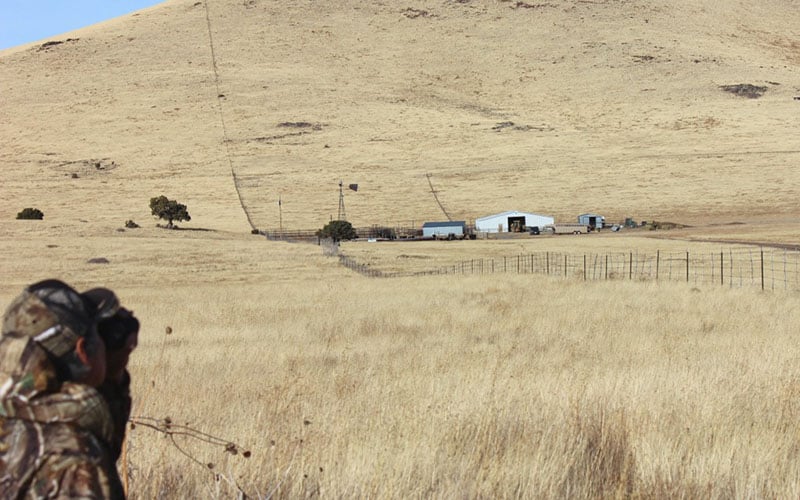
Following are longest distances that I ranged with the 7i VR for animals and objects listed. Some required multiple attempts to obtain a measurement reading. Also please note that these do not necessarily represent the maximum distance this model will measure for the given target:
| Target | Distance | Reflectiveness | Weather Conditions |
| Pronghorn broadside | 794 yards | moderate | partly cloudy & dry |
| Pronghorn – head only | 527 yards | low | overcast & dry |
| Elk cow | 612 yards | low | overcast & dry |
| Elk bull – muddy coat | 440 yds – no reading | low | clear & sunny / shaded |
| Bighorn sheep | 585 yards | low | clear & sunny |
| Beef cow – black | 241 yards | very low | clear & sunny |
| Beef cow – red & white | 472 yards | moderate | clear & sunny |
| Horse – small grey | 643 yards | moderate | light rain |
| Horse – large brown | 481 yards | low | clear & sunny |
| Dog – yellow lab | 357 yards | moderate | overcast & damp |
| Dog – chocolate lab | 292 yards | low | overcast & damp |
| Dog – black lab | 96 yards | very low | overcast & damp |
| Red-tailed hawk | 266 yards | low | clear & sunny |
| Building – concrete | 1178 yards | high | partly cloudy & dry |
| Water tank – metal | 1094 yards | high | clear & sunny |
| Barn – metal | 980 yards | high | partly cloudy & dry |
| Rock butte face | 976 yards | high | partly cloudy & dry |
| Billboard – light metal | 787 yards | high | light snow |
| Billboard – dark vinyl | 616 yards | moderate | light snow |
| Pine tree trunk – large | 598 yards | moderate | partly cloudy & dry |
| Juniper tree foliage | 534 yards | moderate | partly cloudy & dry |
This data shows the 7i VR will read beyond the 1000 yard maximum rating on highly reflective surfaces, and also beyond the 500 yard mid-point benchmark on most animals – with the notable exception of black ones. I found it remarkable that I was able to range the heads of pronghorn bedded in 18-inch grass out to 527 yards, with many of the readings coming on the first attempt while hand-holding the unit without a rest! I also found it easy using both hands to hold the target mark in the viewer on moving pronghorn, bighorn sheep and elk for continuous ranging out to 500 yards. And, the ranging button atop the unit is well positioned and easy to depress, even while wearing light gloves.
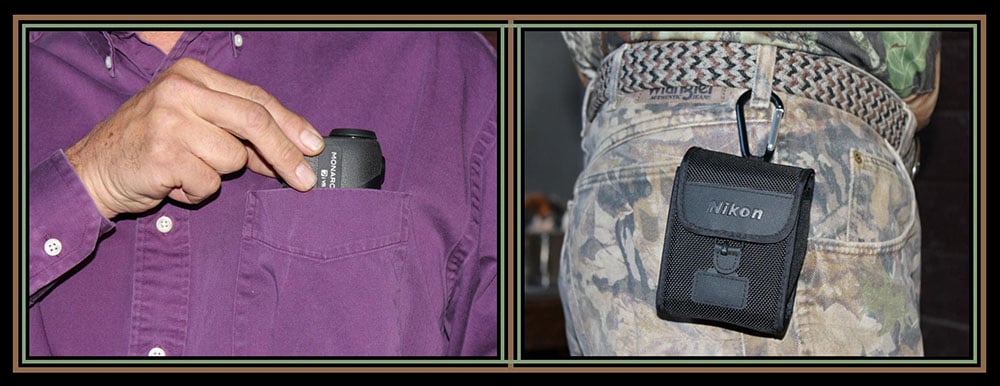
Following is a list of 7i VR features, with my assessment of each for practical use in the field based on ranging more than 1000 animals in a variety of weather conditions:
- Vibration Reduction Technology – facilitates quick ranging of both stationary and moving targets as advertised. This is the single best feature of the 7i VR.
- Continuous Ranging – works as advertised for up to 8 seconds. Most useful for precise shot placement by bowhunters at close range, marginally useful for rifle hunters at any range.
- ID (Incline/Decline) Technology – user selectable from actual to “horizontal” distance to compensate for uphill/downhill shot angles. Excellent feature that tested accurate, particularly useful for rifle hunters in mountainous terrain and treestand bowhunters.
- First/Last Target Priority – user selectable for overlapping targets or when brush partially obscures target. Particularly useful when reflective objects are closer to user than desired target, useful for rifle and bowhunters, accuracy 80%+.
- Distance Readings in half a second – user selectable in yards or meters.
- Diopter Adjustment – eyepiece dial for vision correction to facilitate sharp focus.
- 6x Viewer Magnification – facilitates clear images augmented by bright Nikon glass.
- Target Mark – clear and uncluttered, facilitates first try measurement.
- Distance Measurement Increment – 0.1 yard/meter, useless for most practical hunting and target applications.
- Ranging Button – well positioned and works well with light gloves, doubles as on/off switch.
- Compact Size & Light Weight – 3.9” x 3.0” x 1.9” (L x H x W), 7.1 oz (without battery), facilitates storage and transport.
- Ergonomic Case – fits nicely in the hand for steady one-hand ranging.
- Waterproof & Fogproof – fully functional as tested in light rain and light snow.
- Accessories – nylon case, neck lanyard & small carabiner type attachment clip.

The final assessment after testing is whether I would purchase and/or recommend the Nikon Monarch 7i VR Laser Rangefinder… or not. Here it’s most useful to refer back to the intended use/functionality issue, with respect to 4 main categories – bowhunting, rifle hunting, dual purpose hunting and target shooting – as noted earlier.
- For bowhunting exclusively from a treestand: Yes, although one of the lower cost archery models would be the first choice for most bowhunters.
- For bowhunting on foot and/or from a ground blind: Yes, although if cost is an issue there are lower cost rangefinders that will get the job done within typical bow range.
- For short to mid-range rifle hunting: Yes, unless black colored animals like black bear and moose are the primary quarry.
- For dual purpose bow and gun hunting: Yes, with minor reservations as noted for black animals and long range shooting.
- For long range rifle hunting: No, other rangefinder models are better suited for shooting animals at ranges greater than 500 yards.
- For target shooting exclusively: No, one of the horizontal orientation models with a built-in fitting for mounting on a tripod would be my first choice.
- For predator hunting: Probably, although I did not have the opportunity to test the 7i VR on predators, using both hands it easily ranged my lighter colored Labrador retrievers romping in a field over 300 yards distant, both stationary and moving.
- For varmint hunting: Possibly, although I did not test on varmints or pests like prairie dogs, one of the more powerful, higher magnification, horizontal orientation models would be a more likely choice, particularly if hunting primarily from a stationary position.




Comments (0)
New 2017 Nikon Products | The Blog of the Gritr Sports Storesays:
January 25, 2017 at 12:07 pm[…] Finally, Nikon officially unveiled their world’s first Rangefinder with Vibration Reduction technology. The Monarch 7i VR works to stabilize the operator’s hand as they range targets, which results in faster, more accurate readings in the field. The Vibration Reduction technology has been prevalent in Nikon cameras, but this is a game-changer to bring the technology to a rangefinder. We were lucky to get our hands on the Monarch 7i VR early, and for a comprehensive review check out Tony Martins’ review at: Nikon Monarch 7i VR Laser Rangefinder Review. […]
BEST OF SHOT 2017 – HUNTING: Part 1 | The Blog of the Gritr Sports Storesays:
January 26, 2017 at 10:52 am[…] Nikon’s new Monarch 7i VR Laser Rangefinder also received lots of attention at SHOT. Promoted as the “World’s First” laser rangefinder to employ optical “Vibration Reduction” (VR) technology, hand movement is reduced so distance to animals can usually be measured with a single push of the ranging button. I reviewed the new 7iVR recently for Gritr Sports. […]